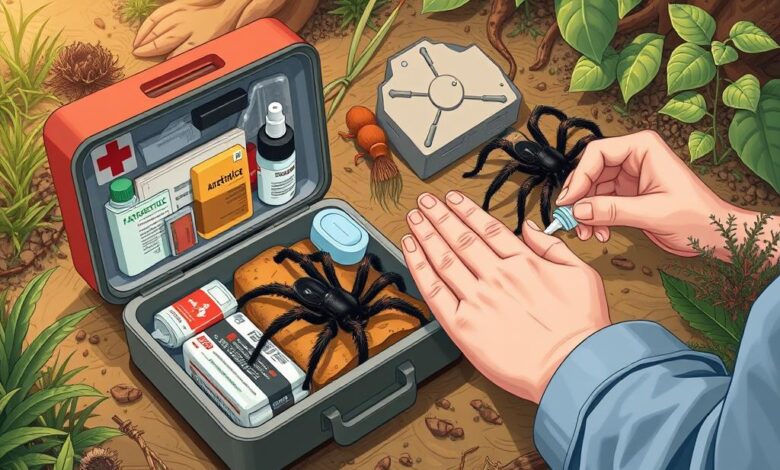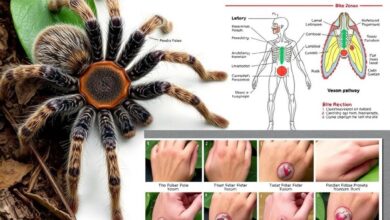Field First Aid for Tarantula Bites

Meeting a tarantula in the wild can be exciting and a bit scary. These big, hairy spiders have venom that can cause bad symptoms if they bite you. But, are tarantula bites as dangerous as stories say? And what should you do if a tarantula bites you?
This guide will teach you how to handle a tarantula bite in the wild. You’ll learn about tarantula venom and how to treat a bite right away. By the end, you’ll know how to act fast and keep safe from these interesting but risky spiders.
Understanding Tarantula Venom and Its Effects
Tarantulas belong to the Theraphosidae family and have different levels of venom strength. Not every tarantula is venomous, but many can bite and cause pain. Knowing which tarantula you’re facing is key to handling the situation right.
Tarantula Species: Identifying Venomous Arachnids
Different tarantulas have varying levels of venom. Some, like those in the Poecilotheria genus, have strong neurotoxins that can cause serious issues. Others, like the Grammostola genus, have milder venom. Knowing which one you’re dealing with helps you know how to react.
Symptoms and Severity of Tarantula Bites
- Mild bites might cause pain, swelling, and redness where you were bitten.
- Severe bites from some tarantulas can lead to nausea, muscle cramps, trouble breathing, and other serious symptoms.
- The effects of a tarantula bite can be anything from mild to life-threatening, based on the type of tarantula.
Knowing what a tarantula bite looks like and how to identify venomous ones is important. It helps you give the right first aid and get medical help when needed.
Immediate Response to a Tarantula Bite
When you get bitten by a tarantula, act fast and follow the right steps. First aid for tarantula bites is key to keep the victim safe and reduce risks.
First Aid Steps for Tarantula Bite Wounds
- Wash the Wound: Clean the bite area with soap and water to get rid of venom or dirt.
- Apply Cold Compress: Use a cold pack or ice to lessen swelling and ease pain. Keep it on for 10-15 minutes.
- Immobilize the Affected Limb: If you can, keep the bitten limb still to stop the venom from spreading.
- Monitor for Symptoms: Watch the victim for signs of venom effects, like feeling sick, dizzy, or having trouble breathing.
- Administer Pain Medication: Give over-the-counter pain relief if needed to help with the pain.
- Seek Medical Attention: If the bite is serious, get medical help right away or call emergency services.
For some bites, spider bite wound care might mean getting anti-venom if symptoms are bad. Always listen to doctors to get the best care for a theraphosidae bite treatment.
Quick action and right first aid for tarantula bites can lower the chance of problems and help the victim feel better.
Tarantula Field First Aid
When a tarantula bites in the wild, acting fast is key. You might not have medical help nearby. But, knowing what to do can keep the victim safe.
Here are steps for tarantula first aid in the field. They are part of your wilderness emergency care and outdoor survival skills:
- Stay calm and check the situation. See how bad the bite is and how the victim feels.
- Clean the bite with water if you can. This removes venom or dirt.
- Put a clean, sterile dressing on the bite. It helps stop bleeding and fight infection.
- Lift the hurt limb up. This can lessen swelling and ease pain.
- Watch the victim for signs of venom sickness. Look for nausea, dizziness, or trouble breathing.
- Try using cold packs or certain plants to ease the pain.
- Be ready for more problems. Know when to give more aid or call for help if things get worse.
Learning these tarantula first aid steps helps you help someone in the wild. It’s part of being ready for emergencies in tough places.
| First Aid Supplies | Quantity |
|---|---|
| Sterile gauze pads | 4-6 |
| Bandages (adhesive and roller) | 2-3 |
| Antiseptic wipes | 4-6 |
| Cold pack | 1 |
| Pain relief medication | As needed |
Preventing Tarantula Encounters
To stay safe from tarantulas, learn about their home and how they act. These spiders live in dry, rocky places with lots of hiding spots like logs and rocks. Knowing where they live and act helps you avoid them when you’re outside.
Tarantula Habitat and Behavior
Tarantulas sleep all day and hide under rocks or in the ground. They hunt at night, using their sharp senses to catch prey. Knowing this helps you be more careful in places where they might be.
Safe Practices for Outdoor Activities
- Wear protective clothing, such as boots and thick gloves, when engaging in outdoor activities in areas known to have tarantula populations.
- Exercise caution when lifting or moving logs, rocks, or other ground cover, as these are common hiding spots for tarantulas.
- Stick to well-traveled paths and avoid venturing into dense vegetation or areas with abundant ground cover where tarantulas may reside.
- Be mindful of your surroundings and watch where you place your hands and feet to avoid accidentally startling or provoking a tarantula.
Learning about tarantula habitat and behavior and following safe practices for outdoor activities lowers the chance of meeting these spiders. This way, you can enjoy nature more without worry.
When to Seek Medical Attention
Most tarantula bites can be treated with basic first aid. But, there are times when you need to get medical help fast. Knowing the signs of a severe bite is key. Quick action can save lives.
Signs of Severe Envenomation
If you notice any of these after a tarantula bite, get medical help right away:
- Difficulty breathing or shortness of breath
- Rapid or irregular heartbeat
- Severe pain, swelling, or redness that spreads beyond the bite site
- Nausea, vomiting, or diarrhea
- Muscle spasms or paralysis
- Blurred vision or drooping eyelids
- Confusion, dizziness, or loss of consciousness
These signs mean the venom is causing a bad reaction or affecting your body in serious ways. Don’t wait for things to get worse before getting help. Quick action is crucial with tarantula envenomation symptoms.
If you’re far from medical help and can’t get there fast, keep the patient safe. Make plans to get them to a hospital or medical place as soon as you can. Using first aid for tarantula bites can help until medical experts arrive.
Handling Tarantula Bites in Remote Areas
If you get bitten by a tarantula in the wild, act fast and use what you have. Start by cleaning the bite with clean water and antiseptic if you have it. This helps prevent infection.
Then, use a cold compress or ice pack on the bite to lessen swelling and pain. If the bite is on a limb, keep it higher than your heart. Use clean clothes or natural fibers as makeshift bandages if you don’t have real ones.
When you can’t find traditional treatments, try natural remedies. For example, a paste of baking soda and water might ease swelling and pain. Also, look for local plants or herbs that can help with inflammation or pain. But make sure they’re safe and effective first.
Your main aim is to keep the person safe and get them to a hospital as soon as possible. Watch for signs of a bad reaction, like trouble breathing or swallowing. Be ready to act fast if you see these signs.




